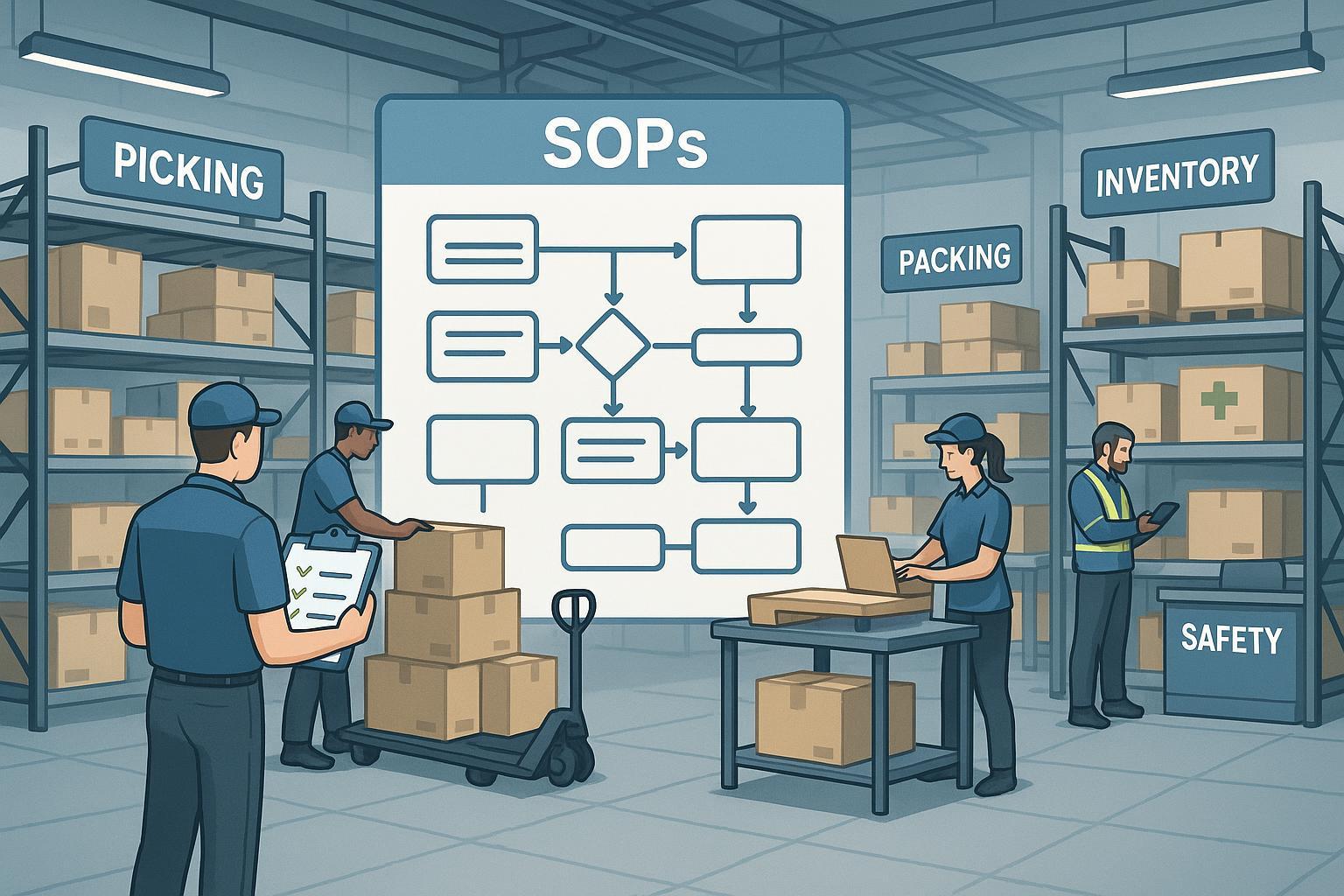
Introduction
In today’s fast-paced supply chain landscape, warehouses face immense pressure to deliver error-free, rapid fulfillment at scale. Yet, operational inefficiency, picking and packing mistakes, and inconsistent staff performance remain persistent challenges. The missing link? Robust Standard Operating Procedures (SOPs). For warehouse managers and logistics leaders, SOPs are not just documentation—they are the backbone of scalable, consistent, and compliant operations. This guide distills the latest industry research, benchmarks, and practical frameworks to help you design, deploy, and continually optimize warehouse SOPs that drive real results.
Why SOPs Matter in Warehouse Operations
Standardizing warehouse processes is not optional—it’s essential. According to GoAudits’ aggregated audit results, warehouses that implement and regularly update SOPs see picking/packing error rates drop from the industry average of 2–3% down to as low as 0.5–1%, and typically enjoy 15–30% improvements in throughput (Source). These gains translate directly to cost savings, improved customer satisfaction, and easier compliance with regulations such as OSHA or ISO standards. Furthermore, leading analysts (Gartner, APICS) highlight SOPs as a requirement for digital transformation and autonomous warehouse optimization.
Core Elements of Effective Warehouse SOPs
A best-in-class SOP for warehouse operations includes:
- Clear Process Scope and Objectives: Defining exactly which tasks are covered (e.g., receiving, picking, packing, inventory control, safety checks).
- Involvement of Stakeholders: Gathering input from frontline staff, supervisors, and compliance experts.
- Simple, Actionable Instructions: Use plain, jargon-free language and bullet points.
- Visual Aids and Flowcharts: Incorporate diagrams, checklists, and photos—improving comprehension and recall (SweetProcess Templates).
- Piloting and Review Cycles: Regularly test, gather feedback, and iterate.
- Version Control and Accessibility: Use digital tools for up-to-date access and tracking changes.
- Integrated Compliance Checks: Ensure alignment with OSHA, ISO, and internal quality standards (OSHA Guidelines).
Stepwise Guide: Building and Implementing Warehouse SOPs
1. Map Critical Processes
Identify vital workflows: receiving, picking, packing, inventory management, safety protocols, and shipping. Use process mapping software or templates for clarity.
2. Collaborate with Your Team
Include input from staff at all levels. Engagement ensures relevance and increases buy-in.
3. Draft Clear, Visual SOPs
Combine step-by-step text with annotated process diagrams. Reference sample templates (SweetProcess Flowcharts).
4. Pilot Test and Refine
Trial SOPs with a small group. Gather feedback, measure outcomes (e.g., time/motion studies), and iterate instructions before full rollout.
5. Train and Certify Staff
Deliver hands-on training, using a blend of on-the-job instruction, visual guides, and digital learning modules. Test comprehension with quizzes or practical assessments.
6. Monitor Adoption and Compliance
Establish periodic audits and compliance checklists to ensure procedures are followed. Digital SOP platforms support real-time monitoring.
7. Review and Continuously Improve
Drive KAIZEN cycles: schedule regular SOP reviews, solicit staff feedback, and update based on warehouse metrics and new tech.
Training, Compliance, & Change Management
- Onboarding: Digital SOPs accelerate onboarding—reducing ramp-up time for new hires and supporting knowledge transfer amid staff turnover (Gartner insights).
- Compliance: Embed regulatory requirements (OSHA, ISO) inside daily workflows, minimizing manual errors and audit risk.
- Change Management: Address staff resistance by involving them early, demonstrating SOP impact (via ROI data), and rewarding compliance. Use feedback loops for agile improvements.
- Troubleshooting: Track error incidents, investigate process adherence, and use root-cause analysis to refine SOPs and retrain as needed.
Measuring SOP Effectiveness: Real-World Results
Implementing strong SOPs isn’t a theoretical exercise—it drives demonstrable results. For example, audits across GoAudits clients report error reductions of 30–50% following SOP rollouts, with order accuracy and time-to-ship metrics improving by 15–30%. Warehouses that integrate visual SOPs and digital versioning see even stronger gains as onboarding and troubleshooting become more data-driven.
Mini-Case Study: Receiving SOP Optimization
A mid-sized eCommerce warehouse piloted a step-by-step receiving SOP, including barcode scanning and digital checklists. Results: receiving errors dropped 40% in three months, cycle times for new shipments improved by 25%, and audit pass rates rose significantly (Source).
Best Practice Tip: Benchmark your performance before/after SOP adoption—track error rates, task cycle times, and audit findings for proof of continuous improvement.
Recommended Tools & Resources
- SweetProcess SOP Flowchart & Template Suite: Download SOP templates & process flowcharts
- GoAudits Warehouse SOP Implementation Guide: Full framework and compliance checklist
- OSHA Guidelines: Regulatory safety SOP compliance
- Editable SOP Checklist: Sample download
(Note: All recommended resources are independently validated and widely adopted across the logistics industry.)
Conclusion
Warehouse operational excellence starts with bulletproof, actionable SOPs—anchored in best practices, supported by real data, and adaptable to your evolving supply chain needs. Regularly updated procedures not only slash costly errors and inefficiencies but also lay the groundwork for digitalization, compliance, and future-proof growth. Leverage the tools and frameworks linked above to accelerate your SOP journey—and revisit your processes quarterly to stay ahead in an increasingly automated and data-driven world.
Further Reading: